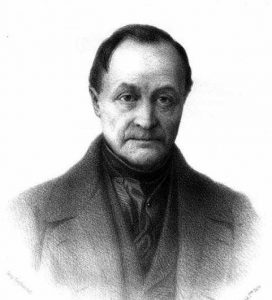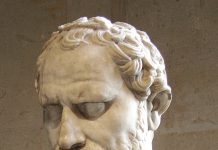“Quite a long, long time ago, when huge shadows were thrown upon the earth but their sources were unknown and men still wandered in rags upon the earth, there stepped a man into a single clearing free of the shadows and the doubts of his fellow men. Though he was a sinner, he cast the first stone, and others believing that this man was destined for a higher purpose, cast stones also. These were the first philosophers. There came along others who put the stones one atop the other until something akin to a Cathedral was built. But gradually, men noticed that the Cathedral itself cast a shadow; it too was a huge shadow and it reminded them of the shadows which had existed before the Cathedral was built. Another man stepped into this shadow and claimed not to be a sinner. He smashed the first stone, and others, believing he was destined to give them a higher purpose, smashed each a stone in turn until the Cathedral lay in crumbles.” Now, if I had to write a history of the enlightenment, this is how I would begin it. John S. Haller Jr. does not begin his history Fictions of Certitude in such a manner, yet he does tell quite extensively about some of the men who stepped into the shadow of that Cathedral and smashed the first stones. His is a history book which studies different shadows; he studies the shadows which were cast even after the Cathedral crumbled, the smaller shadows which were cast by the very smashers themselves. I call those shadows self-doubt. He studies nine different intellectuals of the Enlightenment and how exactly they reconciled themselves with the doubts and uncertainties caused by the crumbling of the Cathedral and the doubts and uncertainties caused by their own shadows; in other words, what was to be done now that the Cathedral was gone. Auguste Comte, Haller’s first case-study, suggested something not unlike the Cathedral which had just crumbled. Comte is perhaps the most significant Positivist ever to live; within his positivist philosophy, he would synthesize all aspects of society for the greatest good. Comte needed synthesis of all areas and classes of society if his vision were to bear fruit. Comte admired the structure and unity which religion had brought to people and he thought that the idea of a priesthood was useful in teaching people of higher purposes; his philosophy would be a secular “Religion. . . ‘Positivist religion’”, structured around a new ruling class. “In Comte’s new society, bankers, merchants, and industrial leaders would eventually hold the reins of political power. . . their functions under constant check by the combined forces of the working class, scientists, and women”. He was pragmatic enough to understand that society needed a pervasive meta-structure, but Comte held that it could no longer be one of superstitious religiosity, which is how he viewed especially Catholicism. He was also pragmatic enough to understand that “loss of faith in God” would catalyze societal chaos. The people needed a spiritual authority, which his Positivist philosophy supplied. Comte was not the only one to desire a synthesized truth without the aid of orthodox religion.
Herbert Spencer also created a quasi-religious system of truth, at least in its scope. His was the religion of sociology, predicated upon the high-priesthood of sociologists. His ideas, similar to Comte and many other Enlightened ones, rooted itself in the theory of evolution. Spencer thought evolution was no “accident”, rather it would instigate the perfection of the human race: “ ‘What we call evil and immorality must disappear. It is certain that man must become perfect’. ” Therefore, Spencer theorized, society must be left as much to itself as possible in order that this holistic perfecting have time to come about. One premise which Haller argues for is that Spencer’s “individualism”, this “laissez-fare” attitude toward society, was appreciated and assimilated greatly into the American consciousness, or at least the American business consciousness. In his likeness to Comte, he maintained an ambition to bring “the whole of knowledge into a single worldview.” In other words, he had a taste for the structure of the crumbling Cathedral, but thought that its many adornments were superfluous and untrue. The Cathedral he attempted to raise would possess new adornments, new windows, a new altar, and a new sacrifice. Spencer considered that his synthesis of knowledge would embrace aspects of science and religion together; science and religion, in his mind, had gradually trespassed upon one another’s territory. Incidentally, John Newman, the only orthodox believer of Haller’s ennead, proposed something not very far different in saying that the theologian and scientist were separate entities, and need not fear one another so long as they maintained the proper separation in their respective works. I must say I was actually quite surprised how many of these Enlightened scholars felt a need to cling to, at the very least, the vestiges of some higher intelligence.
Alfred Russel Wallace, the very co-founder of evolution, wrote out: “ ‘a superior intelligence [had] guided the development of man in a definite direction, and for a special purpose.’ ” He was influenced by Spencer regarding his theory of the future of the human race. Mankind’s intellectual principle would evolve for many years yet, while his body had finished its ascent into created glory. Just as Spencer predicted the perfecting of all men, Wallace dreamed of how a single, “homogeneous” race would come to be, each specimen flawless and seeking mutual happiness in relation to its fellows. Evolution, indeed, became almost the Salvator of mankind. The natural evolutionary progression must rescue man from his lower realities. Wallace himself did not always believe in a higher intelligence guiding evolution. Not all believed in anything supernatural, and others believed in something so soup-like and insubstantial that the belief became purely theoretical. Thomas Huxley was an agnostic; John Fiske was a theist in the most tenuous of terms; John Carus seemed more attracted to the idea of a higher principle than its reality; and William James simply thought that religion had a pragmatic value, but he did not much care about God or his existence. He cared about man striving toward a higher state, a higher reality always, than the one in which he presently existed. And this leads me to one of the great, perhaps the greatest strength, of Haller’s writing and research. He, within the microcosms of these nine men, threads together a larger worldview towards which society after the Enlightenment tended. His writing and his research finance an atmosphere which pulls together the connections between each of these nine individuals and their ideas, and in the very final chapter uses the links to offer perhaps a solution to the problems of modernity.
I am not able to carry the thread as it should be carried in this review; I do not have the benefit of 262 pages (the length, minus notes, of Haller’s book), so I must only cover what I consider the three most major figures Haller covers. I have yet to read a book so complexley researched, and so generously connected. His research seems to me almost flawless, and the mistakes which he makes are so insignificant as to be not at all relevant. He becomes perhaps pretentious at times, but that seems inherent in an academic’s DNA, and is certainly not excessive. But let me briefly return to Haller’s corona res, his crowning idea, his reason, it may even be, for writing the book. “The late nineteenth-and early twentieth-century quest for certitude, however flawed it may have been, proved much more genuine by comparison to the tribalism, fragmentation, and loss of vision that mark our current condition.” I am not so sure I understand this statement. Certainly, the attempts of Haller’s nonet of scholars to seek out truth was more genuine than present modern attempts. Their efforts to synthesize the whole of knowledge for the betterment of society is also contrasted to the continued fracturing of the modern academy, a business tendency which is really lamentable. But in many ways it is the ideas which were created by these very men which has led to the darkness of the twenty-first century. The near-universal loss of faith, the lack of discernment of permanent meaning, the ruling of the population by a select group of experts (a vision of Spencer’s), are leaves upon the enlightenment stem. Or perhaps statues upon the Enlightenment Cathedral. I do not even care so much whether the Enlightenment brought a dawn of truth; the fact remains that one Cathedral crumbled due the efforts of these men, and though they admirably attempted to raise a new one, the clearing of the former Cathedral is still without a replacement edifice. The clearing is littered with rubble and the footprints of wandering people, people who seem to be looking for that edifice which was lost. And no longer are the shadows across that clearing cast only by the people who wander across it, for there seems to be discernible a larger shadow, a shadow reminiscent of the shadow which existed before the ancient inception of the ancient Cathedral. And the darkness it conveys extends itself each hour and each day, as we slip back into the crumbles of pre-civilization.
There is a typo on pg 2: “it this” should be “in this”
John S. Haller Jr. is emeritus professor of history and medical humanities at Southern Illinois University.
Fictions of Certitude is $54.95 from University of Alabama Press.














